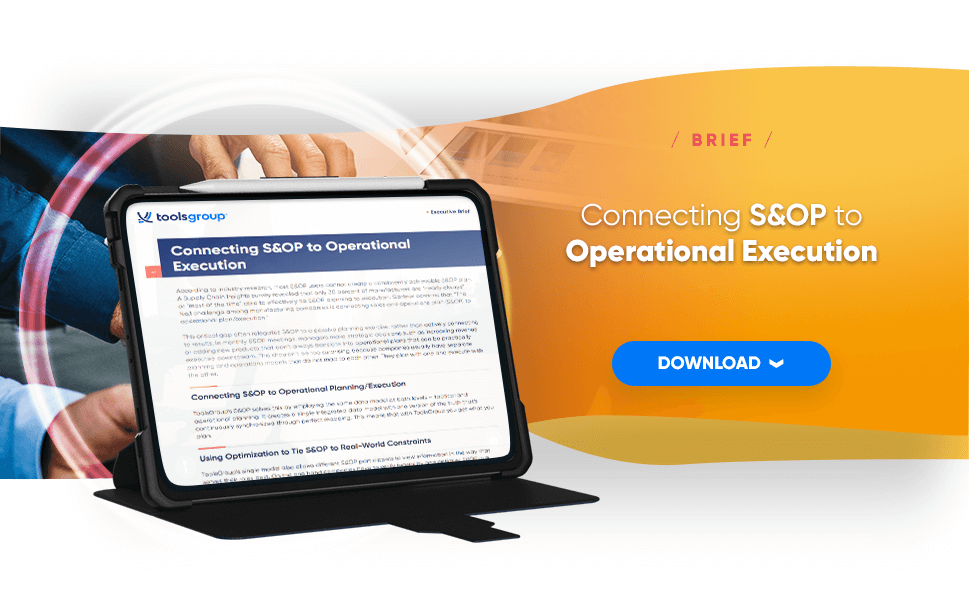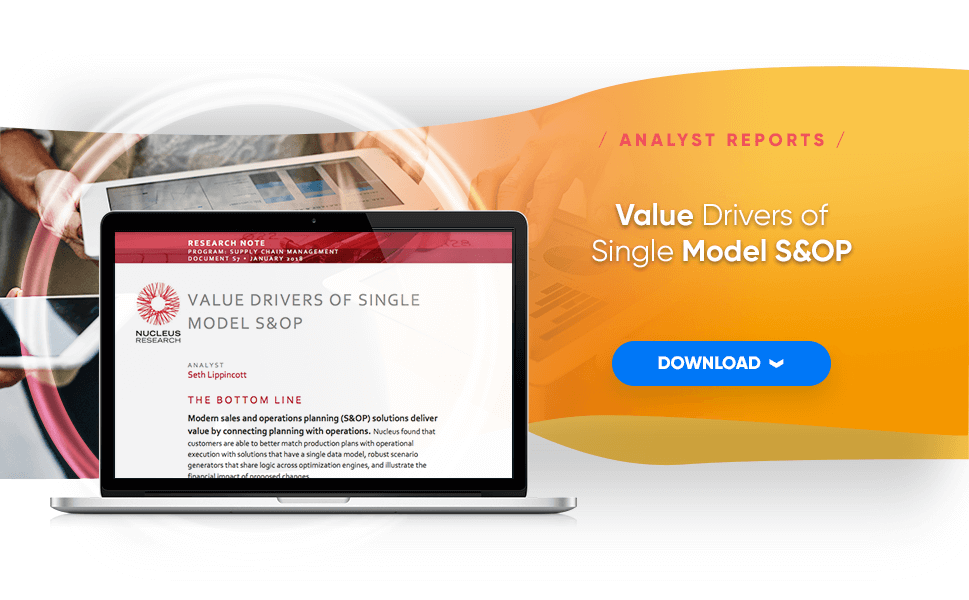
S&OP (Sales and Operations Planning) or SIOP (Sales, Inventory and Operations Planning) is a well known supply chain planning process, yet not all supply chains have embraced Sales and Operations Execution (S&OE). As we all know, what you plan for and what actually happens can frequently be two very different things. The role of S&OE is to capture the differences and adjust.
A few years ago, I introduced an S&OP process to a fast-moving company that was mired in day-to-day execution. At first, we struggled to get the focus on the 18-month planning horizon. Most of the business decisions and focus in the executive S&OP meeting were four weeks out. These were important decisions that needed to be made, but they didn’t really belong in the S&OP meetings and they didn’t really belong in daily supply chain planning either. To get the company focused on the future without neglecting the present, I introduced an interim process linking S&OP and daily planning: S&OE. This critical addition freed up the executive S&OP to focus on the rolling 18-month time horizon and kept the daily supply chain planning aligned with the business strategy. It was just what we needed to gain better alignment between the functions, ensure rapid response to market changes and increase market share while reducing cost.
S&OE is critical for a successful S&OP
“The No. 1 challenge among manufacturing companies is connecting sales and operations planning (S&OP) to operational plan/execution,”1 says Gartner analyst Marko Pukkila. Business, operations and supply chain planning leaders in many companies often miss this, and they end up with a process that does not work well for either planning or execution. Gartner defines the S&OE process as the “capability that bridges this challenge by building a link that connects the higher-level plans to execution through S&OP.”
S&OP can’t achieve its full potential without strong, consistent follow-through. This is why S&OE is critical for a successful S&OP–it links tactical planning with granular execution. Sales and Operations Execution’s near-term, detailed actions on the supply chain provide a “checkpoint for the supply chain and business leaders to ensure that the reality and plans remain aligned,” Gartner states.
S&OE provides a critical link between monthly planning and daily execution
Many companies are beginning to agree with Garther that they should have three distinct supply chain planning horizons–annual, monthly and weekly.
- Annual planning/budgeting focuses on business decisions with long lead times: such as adding or removing capacity, developing new products or entering new markets
- Monthly S&OP focuses on planning at the product family level
- Weekly S&OE focuses on the SKU level, tracking how demand and supply match the plan
Problems begin to arise when annual planning, monthly S&OP and day-to-day supply chain planning (SCP) are developed separately, with little to no interconnections. Having an integrated process that spans the different time horizons is critical to planning and execution success.
This is the S&OE charter: to compare demand to forecast and make sure production can deliver—via fast operational pivots like inventory buffers, lead times, and asset utilization. This visibility also helps the business determine if the sales and operations plan is working—if so, long-range planning is likely on track as well.
Pukkila believes that without a good connection between planning and execution, many companies needlessly overact to short-term volatility. S&OE offers a dampening effect.
S&OE smooths the day-to-day volatility for more controlled operations
In Set Up Sales and Operations Execution Process to Support the S&OP Cycle Pukkila explains, “Because of the short-term view to the supply chain and manufacturing management, the day-to-day noise and volatility seem worse than it may be. The result in many companies in this situation is that they are in a perpetual reactive, firefighting mode that causes expedites of raw materials, frequent rescheduling of the production and possibly outbound priority transportation to meet customer expectations. All this reactivity is adding cost to the supply, which erodes the business profitability. If someone took a step back and looked at the bigger picture, they would likely find that the overall month-to-month volatility isn’t that bad after all. S&OE is the process that has been shown to help manage and absorb the day-to-day noise and provide a more controlled and collected mode of operations to the supply chain and shop floor. Most importantly, it establishes a means to better control the costs and impact the business profitability.”
He concludes, “Whenever work deviates from standard process, standard cost assumptions become null and void. For business leaders and profit and loss (P&L) owners to truly be in control of the business, they have to insist on having a robust S&OE process in place. It is there to help with the day-to-day noise and provide a more controlled and collected mode of operations; the fires may never go out, but at least they can be well contained.”
S&OE translates the results of the tactical plan into the details that drive the near-term actions in the end-to-end supply chain. By monitoring the actual demand and supply numbers by line item, S&OE provides an early warning system that helps business stakeholders adjust their plans and responses. This keeps the supply chain out of firefighting mode, smooths relationships with customers and suppliers, and helps sustain margins by reducing expediting and other short-term reactionary responses.
S&OP, S&OE and supply chain planning stay aligned with a single data model
Staying aligned and making sure decisions are reflected throughout the various planning horizons requires a single data model. Changes made at the S&OP/S&OE level need to be pushed down to the daily execution level. Likewise, the S&OP and S&OE processes need to have the latest data from the daily supply chain planning process. Without a single data model, it is easy for these processes to get out of sync–someone will be missing vital information that could change the decisions they make. Keeping your processes aligned often means you have to address keeping your digital transformation journey on track–address uncertainties, combat biases, include the right level of data in the appropriate data model. Tackling the dirty data challenge provides the foundation for a robust process that produces high quality decisions.
Getting started with S&OE
Gartner says that one common issue to address right away is to identify the S&OE content in the S&OP process and move it to the S&OE agenda. These need to be two separate processes, both clearly defined with purpose and scope:
- The S&OP process focuses on the tactical horizon, typically from 3 to 18 or 24 months. When developing the process timing, the key point in the calendar is the existing business planning meeting. This has to become the executive S&OP meeting, and the process steps leading to that have to be backward scheduled accordingly. It should be noted that it is extremely likely that this S&OP cycle will not necessarily line up with the normal calendar months and weeks, but it will be okay. The new S&OP process will not focus on the current month or the next. The primary focus will be on getting the best midrange plan in place and making the best trade-off decisions.
- The S&OE process covers the near-term horizon, commonly 0 to 3 months, but can vary by business and industry, depending on the manufacturing lead times. Its focus is on the operational issues at the master production schedule (MPS) level of detail. This is the forum where the issues stemming from the lumps and bumps from actual demand and supply can be reconciled with the nice-and-smooth plan that came down from S&OP. Because the reality is never as smooth and polished as S&OP plans indicate, there can be no effective S&OP process without an S&OE process, just like the “P” in Plan-Do-Check-Act (PDCA) doesn’t do much without the “DCA.”
1. Set Up Sales and Operations Execution Process to Support the S&OP Cycle, Marko Pukkila, refreshed 6 July 2020
The source of this article is from ToolsGroup
By Lachelle Buchanan



